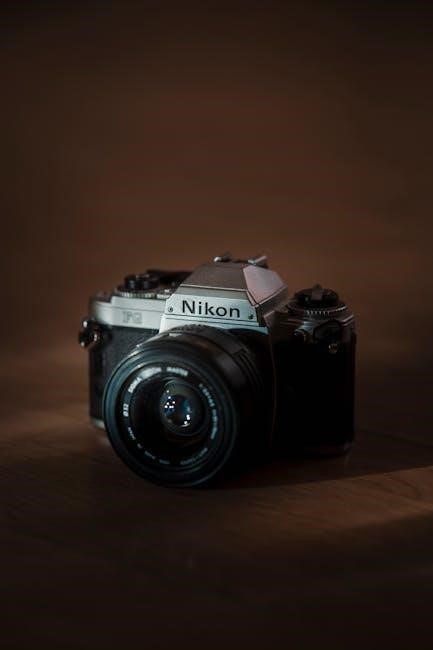Welcome to the Nikon EM Manual, your comprehensive guide to mastering the Nikon EM camera. This manual provides detailed instructions, troubleshooting tips, and best practices for optimal use. Explore its features, understand camera functions, and discover how to achieve professional-grade photography with ease. Designed for both beginners and experienced photographers, this manual ensures you unlock the full potential of your Nikon EM.
1.1 Overview of the Nikon EM Camera
The Nikon EM is a compact and lightweight 35mm film SLR camera, designed for ease of use while offering advanced features. It features aperture-priority and manual modes, a built-in light meter, and compatibility with Nikon’s Series E lenses and Nikkor AI/AIS lenses. The camera is ideal for both beginners and experienced photographers, combining simplicity with functionality. Its durable design and intuitive controls make it a reliable choice for capturing high-quality images in various lighting conditions.
1.2 Importance of the Manual for Optimal Camera Use
The Nikon EM Manual is essential for unlocking your camera’s full potential. It provides detailed guidance on operating the camera, troubleshooting common issues, and mastering advanced features. Whether you’re a novice or an experienced photographer, the manual offers clear instructions for optimal performance. It covers everything from basic functions like loading film and battery installation to advanced techniques for exposure control and lens compatibility. Referencing the manual ensures you understand the camera’s capabilities and achieve the best results in every shooting scenario.

Key Features of the Nikon EM
The Nikon EM features an advanced metering system with Silicon Photo Diode technology, robust design, and compatibility with Nikon lenses and accessories, ensuring precise and versatile photography.
2;1 Overview of the Camera’s Design and Build
The Nikon EM is a compact, lightweight film SLR designed for portability and durability. Its body combines metal and plastic materials for balance and strength. Weighing just 460 grams, it is easy to carry. The camera features a manual focus design with a bright viewfinder and a reliable mechanical shutter. Its aperture-priority mode simplifies exposure control, while compatibility with Nikon Series E lenses enhances versatility. Built for both enthusiasts and professionals, the EM offers a blend of simplicity and functionality, making it a timeless choice for photography.
2.2 Advanced Metering System and Exposure Control
The Nikon EM features a silicon photo diode meter for precise exposure calculations. It offers aperture-priority mode, allowing users to set the aperture while the camera adjusts the shutter speed. The metering system provides accurate readings for a wide range of lighting conditions. A center-weighted metering pattern ensures balanced exposures. Manual override is also possible, giving photographers full control. This combination of automation and manual options makes the EM versatile for various shooting scenarios, catering to both casual and advanced photographers seeking creative control over their images.
2.3 Compatibility with Nikon Lenses and Accessories
The Nikon EM is compatible with a wide range of Nikon lenses and accessories, including Series E and Nikkor AI/AIS lenses. It supports interchangeable lenses, offering flexibility for different photography needs. Accessories like the MD-E motor drive enhance functionality, allowing for faster shooting. The camera also works with Nikon flash units and cases, ensuring seamless integration with the Nikon ecosystem. This compatibility makes the EM versatile for photographers seeking to expand their creative options while maintaining consistent quality across their equipment.
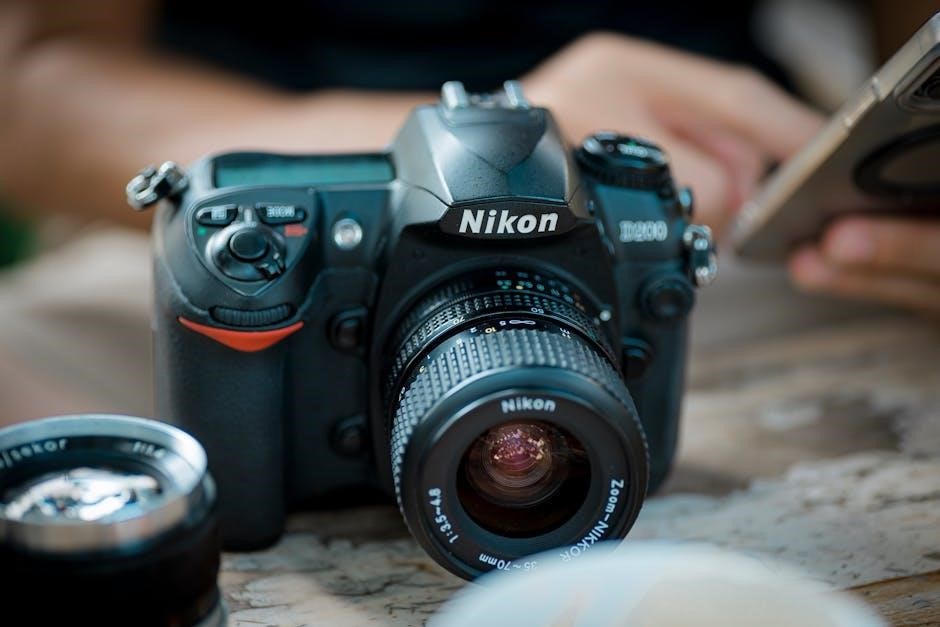
Understanding the Nikon EM Manual
The Nikon EM Manual is your ultimate guide to mastering the camera’s features, operations, and troubleshooting. It provides clear instructions for optimal use, ensuring photographers of all skill levels can harness the camera’s full potential seamlessly.
3.1 Structure and Content of the Manual
The Nikon EM Manual is organized into clear sections for easy navigation. It begins with an introduction, followed by detailed chapters on camera operations, advanced features, and maintenance. Each section provides step-by-step instructions, diagrams, and troubleshooting tips. The manual also includes appendices for quick reference. This logical structure ensures users can quickly find information, from basic functions like loading film to advanced techniques like manual exposure control. It’s designed to be both comprehensive and user-friendly.
3.2 Navigating the Manual for Specific Features
The Nikon EM Manual is designed for easy navigation, allowing users to quickly locate specific features. Use the table of contents or index to find detailed explanations of camera functions, shooting modes, and accessories. Each section is clearly labeled, with step-by-step guides and diagrams to enhance understanding. Whether you’re looking for advanced metering systems or troubleshooting tips, the manual’s logical layout ensures effortless access to the information you need to master your Nikon EM.

Basic Camera Operations
Master the fundamentals of the Nikon EM, including loading film, battery installation, setting exposure, focusing, and basic shooting modes. Essential techniques for everyday photography are explained clearly;
4.1 Loading Film and Battery Installation
Start by opening the camera back and aligning the film leader with the spool. Gently advance the film until it secures, then close the back. Next, install the battery by removing the battery clip, inserting the cell correctly, and reattaching the clip. Ensure the battery is functional by checking the exposure meter in the viewfinder. Proper film and battery installation are crucial for smooth camera operation. Follow these steps carefully to avoid any issues during shooting.
4.2 Setting the Exposure and Focusing
To set the exposure, use the aperture and shutter speed controls. Align the meter needle in the viewfinder with the center mark for proper exposure. For focusing, rotate the lens focusing ring until your subject appears sharp in the viewfinder. Ensure the lens is set to the correct distance. The Nikon EM’s metering system aids in achieving accurate exposures. Proper focusing ensures clear images. Always double-check these settings before shooting to guarantee optimal results.
4.3 Shooting Modes and Basic Techniques

The Nikon EM offers multiple shooting modes, including Auto, Manual (M90), and Bulb (B). In Auto mode, the camera sets aperture for proper exposure. Manual mode allows precise control over aperture and shutter speed. Bulb mode keeps the shutter open as long as the release is pressed. Basic techniques include setting film speed, focusing accurately, and checking battery power before shooting. Experiment with modes to master various lighting conditions and achieve desired effects. Proper technique ensures sharp, well-exposed images every time.
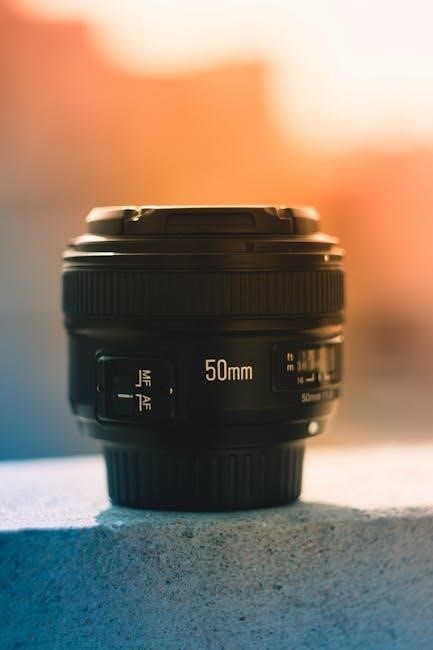
Advanced Features and Settings
Explore manual control, Shutter Priority, and ISO adjustments for precise photography. Utilize the Silicon Photo Diode meter for accurate exposures. Customization options enhance creative control, ensuring optimal results.
5.1 Manual Control and Customization Options
The Nikon EM offers manual control, allowing photographers to set exposures precisely. Use the 1/90th second shutter speed or B mode for long exposures. Customize settings to suit your style, ensuring creative freedom. The camera supports Series E lenses, providing full compatibility. Manual focus and aperture control enable precise adjustments. Learn to activate the exposure meter by removing and reattaching the battery clip. These features make the Nikon EM versatile for both casual and professional photography, ensuring exceptional results with proper technique.
5.2 Using the Shutter Priority and Manual Modes
Shutter Priority mode on the Nikon EM allows photographers to set a specific shutter speed, with the camera adjusting the aperture. In Manual Mode, photographers can set both the shutter and aperture. Reset the shutter operation mode selector from AUTO to M90 for a fixed 1/90s speed. Use the exposure meter by removing and reattaching the battery clip. Fast speeds freeze motion, while slow speeds create artistic effects. These modes offer precise control for creative photography, ensuring professional results with practice and customization.
5.3 Adjusting ISO and White Balance Settings
On the Nikon EM, ISO settings are determined by the film speed, as it’s a film camera. Higher ISO films (e.g;, 400, 800) offer greater sensitivity for low-light conditions but may introduce more grain. White balance is managed through film type selection—daylight or tungsten balanced. Use filters or external lighting to adjust for different lighting conditions. Ensure optimal results by selecting the right film and accessories, leveraging the camera’s compatibility with various Nikon lenses and flashes for precise control over your photography.
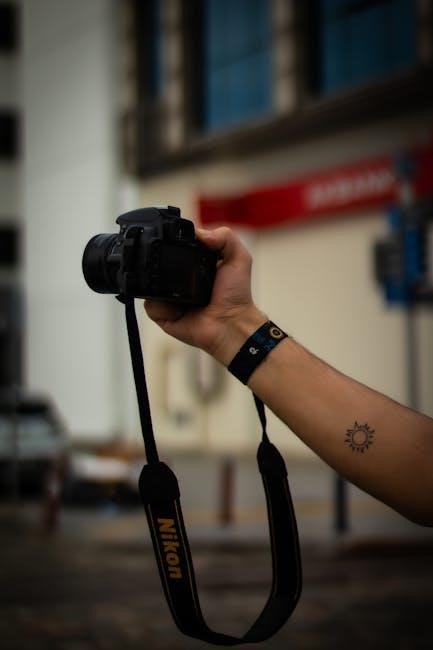
Maintenance and Care
Regularly clean the camera and lenses with a soft cloth to prevent dust buildup. Store the Nikon EM in a dry, cool place to maintain its functionality and longevity.
6.1 Cleaning the Camera and Lenses
Regular cleaning is essential to maintain the Nikon EM’s performance. Use a soft, dry cloth to wipe the camera body and lenses, avoiding harsh chemicals; For stubborn smudges, lightly dampen the cloth with distilled water. Never touch the lens surface with bare hands, as oils can leave residue. Clean the viewfinder and mirror gently to prevent scratches. Store cleaning supplies in a dry place to ensure they remain effective for future use. Proper maintenance ensures crisp, clear images and prolongs the camera’s lifespan.
- Clean lenses with a microfiber cloth or lens tissue.
- Inspect and clean the viewfinder regularly for optimal visibility.
- Avoid using alcohol or ammonia-based cleaners on any part of the camera.
6.2 Storing the Camera Properly
Store your Nikon EM in a cool, dry place to prevent damage from humidity and temperature fluctuations. Use a protective case or pouch to shield it from dust and scratches; Avoid direct sunlight and extreme temperatures, as they can degrade the camera’s components. Consider using silica gel packets to absorb moisture. Before long-term storage, remove the battery to prevent corrosion. Regularly inspect stored items to ensure they remain in good condition. Proper storage extends the camera’s lifespan and maintains its functionality for years to come.
- Use a protective case to prevent scratches and dust buildup.
- Avoid storing in humid or extreme temperature environments.
- Check silica gel packets periodically to ensure effectiveness.
6.4 Troubleshooting Common Issues
Troubleshooting the Nikon EM involves addressing common issues like exposure meter malfunctions or battery drain. If the exposure meter isn’t functioning, ensure the battery is fresh and properly installed. For shutter issues, reset the mode selector to “AUTO” or “M90.” Clean the lens and viewfinder regularly to avoid debris interference. Consult the manual or online forums for detailed solutions. Regular maintenance can prevent many of these problems, ensuring your camera operates smoothly for years. Always refer to trusted sources for accurate fixes.
- Check battery condition and installation for meter issues.
- Reset shutter mode selector to “M90” for consistent results.
- Clean lens and viewfinder to prevent debris interference.
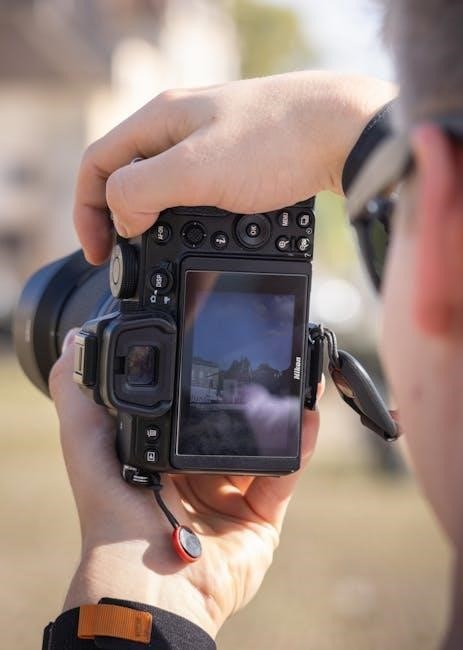
Accessories and Compatible Equipment
The Nikon EM supports various accessories, including Nikon Series E lenses, motor drives, and flash units, enhancing functionality and versatility for photographers.
7.1 Recommended Lenses for the Nikon EM
The Nikon EM is compatible with a wide range of lenses, including the Nikon Series E lenses, which are lightweight and compact. These lenses, such as the 50mm f/1.8, are ideal for everyday photography. Additionally, Nikkor AI and AIS lenses offer excellent optical performance and are fully compatible with the EM. For versatility, consider lenses with focal lengths between 28mm and 200mm. These options ensure sharp images and adaptability for various shooting scenarios, making the Nikon EM a versatile tool for photographers of all levels.
7.2 Using Flash and External Lighting
Enhance your photography with the Nikon EM by utilizing flash and external lighting. Genuine Nikon speedlights are recommended for optimal performance, providing consistent illumination in low-light conditions. Use flash to freeze moments, reduce shadows, or create dramatic effects. Experiment with techniques like bounced light or diffused flash for softer, more natural results. While the EM lacks a built-in flash, external units offer greater flexibility. Sync your flash with the camera’s shutter speed for balanced exposures and explore creative lighting setups to elevate your photography skills.
7.3 Motor Drives and Other Accessories
The Nikon EM supports a range of accessories, including the MD-E motor drive, designed to enhance shooting efficiency. This motor drive enables automatic film advance, making it ideal for rapid shooting sequences. Additional accessories like the CF-11 ever-ready case provide protection and convenience. Use genuine Nikon accessories to ensure compatibility and optimal performance. These tools expand the camera’s functionality, catering to both casual and professional photographers. Explore the full potential of your Nikon EM with these tailored accessories for improved photography experiences.

Tips for Getting the Best Results
Master lighting and composition to enhance your shots. Experiment with different film types for unique effects. Optimize focus and depth of field for sharper images. Practice makes perfect—keep exploring!
8.1 Understanding Lighting and Composition
Lighting is crucial for capturing stunning images with your Nikon EM. Natural light, especially during the golden hour, enhances colors and textures. Experiment with side lighting to add depth and backlight for dramatic silhouettes. Use flash in low-light conditions to illuminate subjects. Compositionally, apply the rule of thirds to balance your frame. Leading lines and symmetry can create visually appealing shots. Practice experimenting with angles and perspectives to add creativity to your photography, ensuring every shot is well-framed and impactful.
8.2 Optimizing Focus and Depth of Field
Mastering focus and depth of field is essential for impactful photography with the Nikon EM. Use manual focus for precise control, ensuring your subject stands out. Adjust the aperture to regulate depth of field—wider apertures blur backgrounds, while narrower ones keep more in focus. Experiment with the lens aperture ring to achieve desired effects. Pay attention to subject distance and lighting to enhance sharpness. Minimize camera shake by using a tripod or faster shutter speeds. Practice these techniques to refine your imagery and storytelling through focused, well-composed shots.
8.3 Experimenting with Different Film Types
Exploring various film types with the Nikon EM enhances creativity and results. Try color negative, slide, or black-and-white films to achieve unique tones and textures. Experiment with different ISOs to capture low-light scenes or vibrant daylight shots. Load film carefully, ensuring proper alignment and tension. Adjust exposure settings based on film type for optimal results. This experimentation allows you to discover your preferred aesthetic, making each roll a journey of discovery and artistic expression.
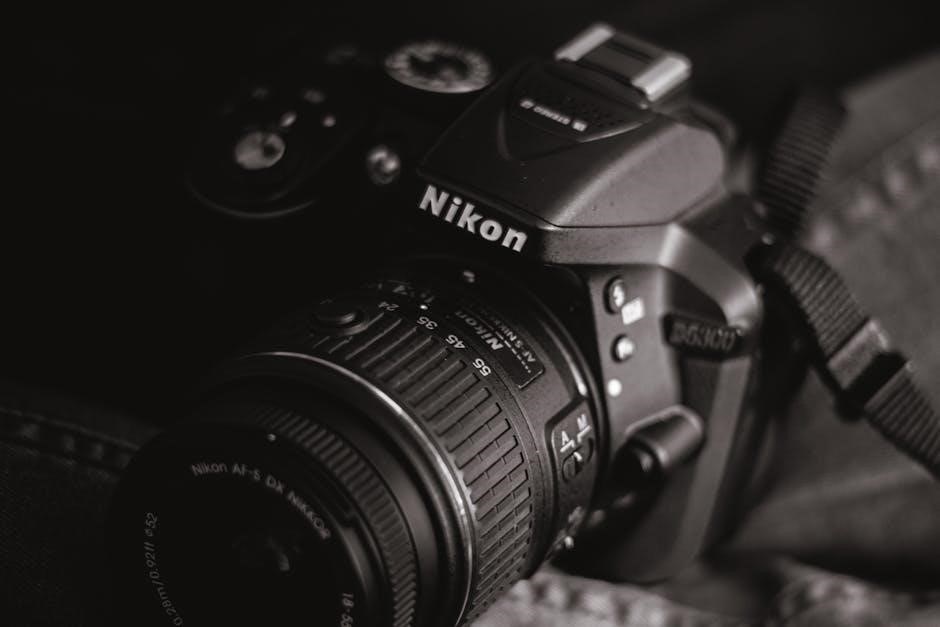
Nikon EM Manual Online Resources
Access the Nikon EM manual online via Nikon’s official website or trusted sources like B&H. Download PDF versions or explore community forums for additional guides and troubleshooting tips.
9.1 Downloading the Manual from Official Sources
To ensure authenticity and safety, download the Nikon EM manual directly from Nikon’s official website or trusted sources like B&H. Visit Nikon USA, navigate to the support section, and select your camera model. Verify the source to avoid unauthorized downloads. The manual is available in PDF format, allowing easy access to detailed instructions, troubleshooting guides, and full-text search functionality. This ensures you have reliable information to maximize your Nikon EM experience.
9.2 Additional Guides and Tutorials
Beyond the official manual, Nikon offers supplementary guides and tutorials to enhance your photography skills. Visit Nikon’s official website or trusted retailers like B&H for video tutorials, workshops, and expert tips. Community forums and photography groups also provide user-generated content, sharing real-world experiences and techniques. These resources help you master advanced features, explore creative shooting modes, and troubleshoot common issues, ensuring you get the most out of your Nikon EM camera.
9.3 Community Support and Forums
The Nikon EM community offers extensive support through forums and groups. Nikon’s official website hosts discussions, while platforms like Facebook and Reddit feature dedicated groups. These forums allow users to share tips, troubleshoot issues, and learn from experienced photographers. Engage with fellow Nikon EM enthusiasts, gain insights, and stay updated on the latest techniques and gear. Community support is invaluable for mastering your camera and enhancing your photography journey.
Mastery of the Nikon EM begins with its manual, unlocking features like precise exposure control and lens compatibility. Explore, practice, and capture life’s moments with confidence and creativity.
10.1 Summary of Key Points
The Nikon EM manual provides a detailed guide to camera operations, from loading film to advanced features like metering and ISO adjustments. It emphasizes proper maintenance and care, such as cleaning and storage, to ensure longevity. The manual also highlights compatible lenses and accessories, offering tips for optimal photography. By following the manual, users can master techniques, troubleshoot common issues, and explore creative possibilities. Practice and experimentation are encouraged to fully utilize the camera’s capabilities and achieve exceptional results in various shooting conditions.
10.2 Encouragement to Explore and Practice
Embrace the journey of mastering your Nikon EM by experimenting with its features and techniques. Practice regularly to refine your skills and uncover new creative possibilities. Explore different shooting modes, lighting conditions, and film types to develop your unique style. Remember, photography is a craft that improves with time and practice. Don’t hesitate to try new approaches and learn from your experiences. The Nikon EM is a versatile tool—use it to capture life’s moments with passion and creativity, and enjoy the rewarding process of growth as a photographer.
